General Performance
Starting out with the overall system performance benchmarks, we have PCMark05, 3DMark03/05/06, and a couple 3D rendering tests. We will also include the CPU results from the 3DMark applications. Note that 3DMark05/06 have multithreaded CPU tests, while 3DMark03 does not.
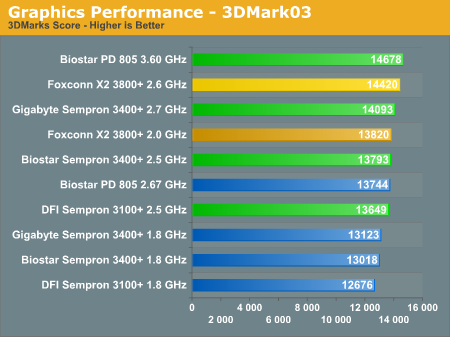

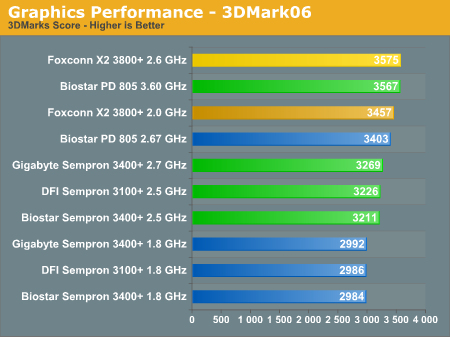
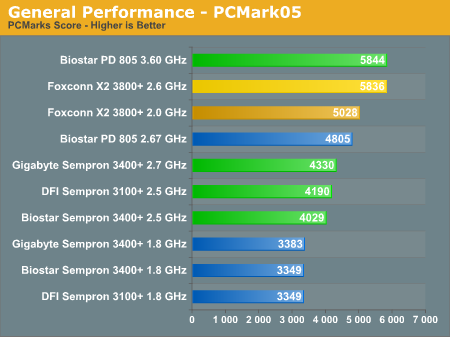
The Pentium D 805 makes an immediate impression as a high-performance budget offering. The margins in 3DMark are not very large, but the Pentium D comes out ahead in all three benchmarks, both at stock speeds and when overclocked. Given that PCMark05 includes several multitasking tests, the greater margin of victory isn't too surprising. However, even if the results are somewhat expected, it does not change the fact that the Pentium D makes a great budget setup for anyone that does moderate amounts of multitasking. If we consider the X2 3800+, it comes out ahead of the Pentium D 805 at stock clock speeds, but overclocking -- at least with this particular graphics card -- results in a dead heat.
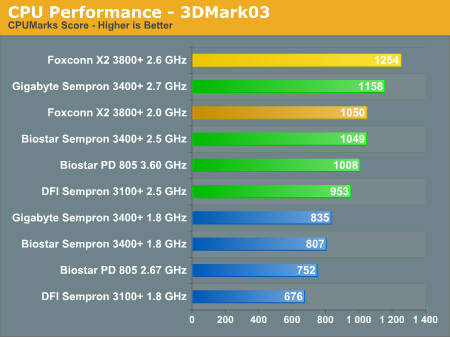
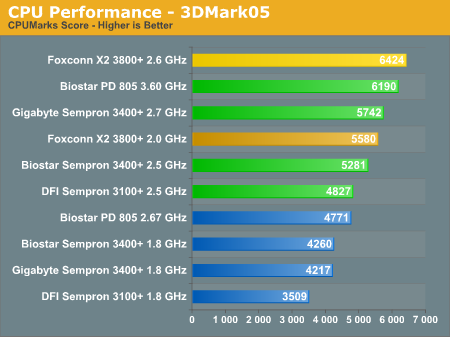
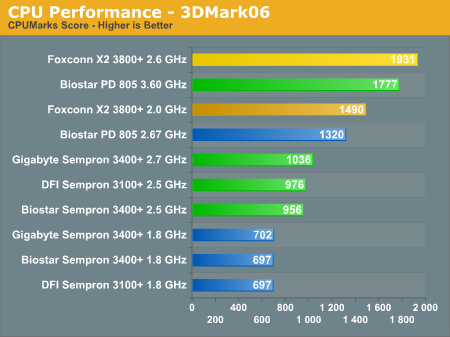
Looking at the 3DMark CPU results, things begin to spread out quite a bit. The X2 3800+ easily leads in these benchmarks, in both stock and overclocked configurations. If we ignore the X2 chip, the Pentium D 805 has a commanding lead in the multithreaded 3DMark05/06, while it trails several of the other systems in 3DMark03. We always mention how 3DMark is really a synthetic graphics benchmark as opposed to real gaming benchmarks, and the same applies to the CPU benchmarks within the 3DMark applications. They show the potential your CPU has to outperform other processors under certain situations, but whether or not real applications perform similarly is going to depend on many factors. Dual core systems definitely have more potential performance, but unfortunately the vast majority of games remain single threaded applications.
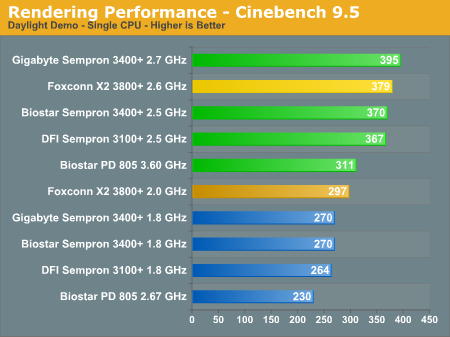
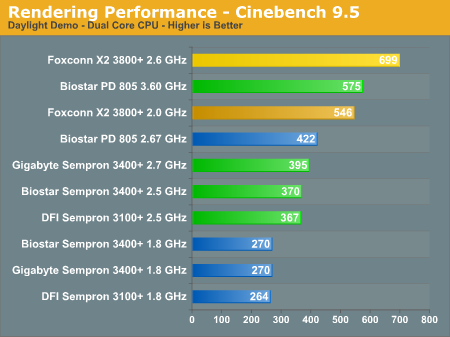
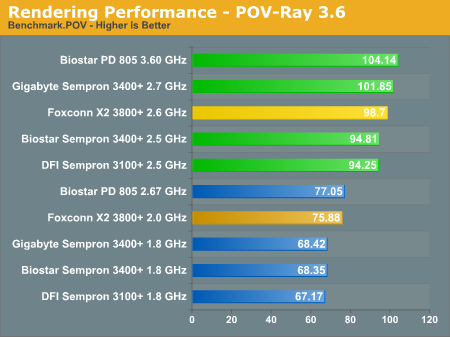
Shifting over to 3D rendering, the Sempron systems are able to do quite well in the single threaded rendering tests. Once SMP support is enabled in Cinebench, the 83% performance increase that the Pentium D and X2 gain easily eclipses the other offerings. POV-Ray also seems to like the NetBurst architecture as the result from our overclocked Pentium 805 is at the top of the chart. It's unfortunate that POV-Ray doesn't support multiple processors, but we could say the same thing about many other applications.
Starting out with the overall system performance benchmarks, we have PCMark05, 3DMark03/05/06, and a couple 3D rendering tests. We will also include the CPU results from the 3DMark applications. Note that 3DMark05/06 have multithreaded CPU tests, while 3DMark03 does not.




The Pentium D 805 makes an immediate impression as a high-performance budget offering. The margins in 3DMark are not very large, but the Pentium D comes out ahead in all three benchmarks, both at stock speeds and when overclocked. Given that PCMark05 includes several multitasking tests, the greater margin of victory isn't too surprising. However, even if the results are somewhat expected, it does not change the fact that the Pentium D makes a great budget setup for anyone that does moderate amounts of multitasking. If we consider the X2 3800+, it comes out ahead of the Pentium D 805 at stock clock speeds, but overclocking -- at least with this particular graphics card -- results in a dead heat.



Looking at the 3DMark CPU results, things begin to spread out quite a bit. The X2 3800+ easily leads in these benchmarks, in both stock and overclocked configurations. If we ignore the X2 chip, the Pentium D 805 has a commanding lead in the multithreaded 3DMark05/06, while it trails several of the other systems in 3DMark03. We always mention how 3DMark is really a synthetic graphics benchmark as opposed to real gaming benchmarks, and the same applies to the CPU benchmarks within the 3DMark applications. They show the potential your CPU has to outperform other processors under certain situations, but whether or not real applications perform similarly is going to depend on many factors. Dual core systems definitely have more potential performance, but unfortunately the vast majority of games remain single threaded applications.



Shifting over to 3D rendering, the Sempron systems are able to do quite well in the single threaded rendering tests. Once SMP support is enabled in Cinebench, the 83% performance increase that the Pentium D and X2 gain easily eclipses the other offerings. POV-Ray also seems to like the NetBurst architecture as the result from our overclocked Pentium 805 is at the top of the chart. It's unfortunate that POV-Ray doesn't support multiple processors, but we could say the same thing about many other applications.










56 Comments
View All Comments
Gary Key - Monday, July 10, 2006 - link
We are currently testing this board for an upcoming Core 2 Duo article, however, at the time Jarred completed this article the board was not widely available nor did our test board have a bios that fully supported all Conroe CPUs. There is not any AMD bias and we are still waiting on more "budget" boards with Core 2 Duo support to be released. It appears at this time we will have to wait until the beginning of August to see the 946PL, G965, and reworked 945 boards that will be in the $65~$100 range.sprockkets - Monday, July 10, 2006 - link
Ha! VIA chipset.PC Surgeon - Monday, July 10, 2006 - link
Doesn't matter if it is a VIA chipset. It's Conroe compatable and cheap.mesyn191 - Wednesday, July 12, 2006 - link
The whole point of going Intel is so that you can use thier chipsets...VIA is OK, but I'd rather have a nV or Intel based board than a VIA one. That mobo is probably a POS BTW, you might as well look at a PCChips board...
jonp - Monday, July 10, 2006 - link
Some observations/questions about this "budget" system:Memory choice: The DDR2 memory choice is given without much analysis. The specific part would be almost
impossible to determine without the article link. It is part number OCZ28001024ELDCGE-K and according to OCZ
http://www.ocztechnology.com/products/memory/ocz_d...">http://www.ocztechnology.com/products/memory/ocz_d...
has timings of 5-5-5-10 at 2.0v where the so called "stock" setting is given as 4-4-4-12-2T at 2.1V.
It appears that this memory is overclocked even in the base performance runs, so those performance numbers
are of no value to the non-overclocker. Some discussion of CAS 5 6400 memory vs CAS 4 5300 memory should have
been included as Newegg has some CAS 4 5300 for $33 less than the 6400 memory chosen which is really CAS 5.
Processor: The choice of a high performance GPU to turn the "budget" system into a gamer has it's own effects.
$192 has overshadowed choices like more memory or faster processors. For only $20 more the processor could
have been an Athlon 64 3500+ 2.2GHz rather than the Sempron 64 3400+ 1.80GHz unit.
Case/Power Supply: Now here is a non-starter. Great that this one "cheap" power supply has lasted for a while.
Lots of us have experience with "cheap" power supplies that would have us avoid choices of this type in the
future. Also, being able to build the exact system has always been a plus with the AdandTech system recommendations.
How could we, in general, duplicate "generic case with iCute 400W PSU purchased "locally"?
DVD: You keep picking the NEC 3550A but without much justifcation relative to equivalent cost Lite-On or other.
Motherboard: You pick the Biostar TForce 550 and then you say "...it seems to be in need of some updates...".
What are we to take from that? Is it a recommendation or not? How was it chosen among the many, many MBs?
Net: I am not really sure what to take from this guide. I don't think I would build this system as such. I am not
sure who the audience is (the only serious gamers I know buy XBox or PS). It doesn't give enough analysis/
criteria information to help make component selections beyond the specifics. I think this one is puzzling.
JarredWalton - Monday, July 10, 2006 - link
I can give you some 5-5-5-15 DDR2-667 numbers as well as 4-4-4-12 DDR2-533, both using G.Skill DDR2-667 RAM. The differences are pretty small, generally less than 3%.I really don't even consider additional voltage on memory to be "overclocking" anymore, as many modules are rated to run with extra voltage and will in fact require it to run at tighter timings. The G.Skill DDR2-667 5-5-5-15 runs at 1.8V with those settings, but with 2.1V I can run it at 4-4-4-12; the same goes for a lot of DDR2 memory.
As for the OCZ RAM, we've http://www.anandtech.com/memory/showdoc.aspx?i=230...">tested similar memory in the past, and we were able to get some nice results with tuning. 5-5-5-10 is the rated speed, but you can certainly do a lot better. I switched to the OCZ because I was trying to determine if it would improve the AM2 performance on the Biostar board (it didn't), and because I had about $30 in "wiggle room" due to the RAM used on the 754 setup.
Again, I would not get cheap DDR RAM for overclocking if you are after ease of endeavor. I've done that as well, and at higher overclocks the performance impact can definitely be substantial. I also wouldn't recommend anyone actually go out and buy the Sempron 754 configurations these days, as dollar for dollar you can get more out of AM2 or 775 platforms. You will never see anything faster than Athlon 64 3700+ (stock speeds) on socket 754, for example.
JarredWalton - Monday, July 10, 2006 - link
I forgot to talk about the Biostar TForce 550 motherboard. It was purchased right around the time socket AM2 launched, and given my experience with the socket 775 TForce board I figured it would make for a good budget overclocking motherboard. There are lots of AM2 motherboards available now, but in the budget price range there are very few that are likely to outperform the Biostar TForce 550 when it comes to overclocking.http://labs.anandtech.com/search.php?q=am2%20mothe...">Here's a list of the AM2 motherboards we're tracking sorted by price. I would be very surprised if any of the integrated graphics solutions overclock well, given my past experience with that type of motherboard, but I could be wrong. For better overclocking, the ASUS M2N-E should perform better (both in overclocking and stock performance).
The Biostar TForce 550 board looks great on paper, but the inability to POST at about 280 MHz HyperTransport bus speeds, as well as the lower performance relative to other AM2 motherboards left me disappointed. You could try the MSI K9N Neo-F, and it may or may not perform better. You can look at the performance achieved by the Biostar TForce 550 with the Sempron chip and compare that to the Gigabyte nForce 590 board with the same chip and you can get a reasonable approximation of the performance you are likely to get with such a configuration.
You want my honest recommendation? Wait until the end of the week and watch how Core 2 Duo performs. Then try to find a budget motherboard that will allow you to overclock the E6300 to 2.8 GHz or higher. It's going to be more expensive than any of the systems used in this article, but it will require less power and provide more performance.
PS -- most of the gamers I know that play with only Xbox or PlayStation do so because they don't know all that much about computers. It's partly a matter of taste, though, as some people will prefer the console gaming experience over a PC gaming experience. There certainly is no correct answer as to which is better, but with the escalating prices of next-generation consoles, budget PC gaming is looking a lot more flexible and attractive. These $650 PCs can also be used to do research and homework at college; try doing that with an Xbox 360, right?
mostlyprudent - Monday, July 10, 2006 - link
I am trying to figure out how the Pentium D 930 (presler) would compare performance wise with the overclocked 805. The overclocked 805 still has a lower FSB, but a higher effective clock speed than the 930. Any thoughts?JarredWalton - Monday, July 10, 2006 - link
You can generally get 4.0 GHz on stock cooling with the 930, so it's faster, runs a bit cooler (not really once overclocked), and it performs better because of the 800FSB default. It depends on the apps you're running, though - as can be seen, you need a better GPU than a 7600 GT for faster gaming performance. You would also want a better PSU for 4.0 GHz 930 overclocking - you can definitely break the 400W mark in such systems.sprockkets - Monday, July 10, 2006 - link
I like the Biostar TForce 6100 board. The power button on the motherboard itself glows blue, and has a reset button on it as well. The fan options on it are very adjustable in the BIOS. Still can use the video card, but I know people here do not prefer uATX.InWin cases are also nice too for the price. They come with 350w power supplies with 12cm fans. Not the best power supplies, but not the worst either.